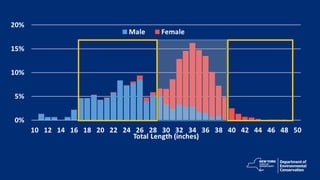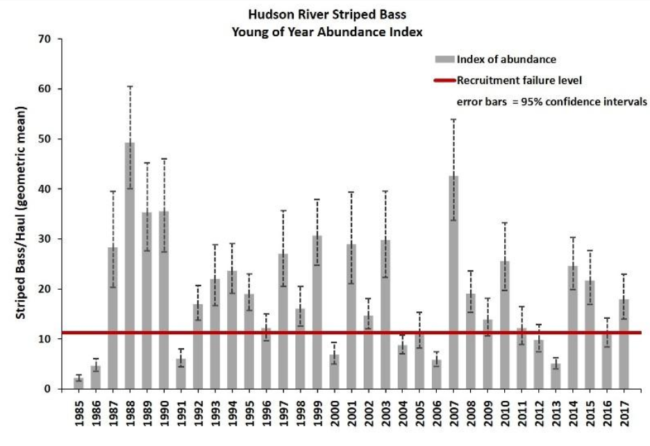Striped bass mortality increases: fishing regs to change

View more images on our Flickr site
Like it or not, change is coming for striped bass anglers all along the Atlantic Coast.
In 2018, the benchmark stock assessment of striped bass conducted by the Atlantic States Marine Fisheries Commission had indicated the stock is overfished. Striped bass are in decline and the downward trend will continue unless mortality is significantly reduced (Figure 1).

Figure 1. NYSDEC young of year index (geometric mean number per haul, weeks 29-45) for striped bass collected in the Hudson River Estuary. Geometric mean is often used when determining a mean for compounded interest calculations, as would occur in recruitment assessments.
To address overfishing, the ASMFC’s Striped Bass Management Board met in May 2019 and proposes measures for both the commercial and recreational fisheries to reduce total mortality by 18 percent to achieve a desired level in 2020. Member states will have to adopt resolutions to achieve these goals.
[UPDATE: Click here for a PDF summary of ASMFC’s annual meeting in late October. All states agreed to make circle mandatory tackle for bait fishermen all along the coast. States will have until 2021 to implement this provision.]
It’s estimated that 90 percent of annual striped bass recreational catch is released alive, of which at least 9 percent are estimated to die as a result of being caught, also known as “release mortality” or “dead releases.” Release mortality is even greater in freshwater and in warmer months. In fact, release mortality for striped bass had accounted for roughly 48 percent of total removals in 2017 and 49 percent in 2018. Adding to the problem, if pre-spawn bass are seriously stressed, they could forego spawning for the entire season. Therefore, it is incumbent upon anglers to take appropriate measures to ensure the survival of striped bass that are released.
Currently, Hudson River anglers (north of the George Washington Bridge) can fish from April 1 to November 30 and can keep one fish per day from 18 to 28 inches or greater than 40 inches. In marine waters, (south of the George Washington Bridge) anglers can keep one fish 28 inches or greater.
As with many other fish, females tend to be larger than males to maximize recruitment potential by carrying enough eggs to ensure a sufficient number will reach adulthood. To protect the striped bass spawning stock biomass, Hudson River anglers have been issued slot limits that are designed to protect the greatest percentage of spawning females. Even though trophy fish (40 inches or greater) can be legally harvested and are undoubtedly female, they form the smallest percentage of the SSB and the odds of catching one is relatively rare (Figure 2.). Many anglers release the trophy class fish because they tend to be the largest females that hold the most eggs. We strongly agree that fish greater than 40 inches should be released.

Figure 2. Length distribution and recreational slot limit (outlined in yellow) for striped bass in the Hudson River Estuary. The slot limit was implemented to protect spawning Hudson River females (pink) while allowing anglers the opportunity to harvest a trophy-sized. The majority of spawning females are in the 28 – 38” class.
Anglers need to use care while catching and handling striped bass, especially if they are taken from the water. To imagine what it is like for a fish after being caught and removed from the water, imagine running a 100-yard dash and holding your breath as long as possible. Most people could not hold their breath even a few seconds. Fish breathe through gills that absorb oxygen from the water. By removing a fish from the water after they have vigorously resisted capture, they are unable to breathe, which adds to their stress.
When practicing catch and release, these steps will greatly aid in the survival of the fish:
- The primary goal is to minimize stress for the fish.
- Quickly land your fish once hooked. Don’t fight it to exhaustion.
- Handle your fish as little as possible and release it quickly.
- Unhooking in water will greatly aid survival and reduce stress on the fish.
- If you must take the fish out of the water, handle it carefully to avoid injury.
- Wetting your hands before handling fish helps keep the protective slime coating on its body.
- Avoid contact with its gills and eyes, and don’t squeeze it or remove its protective slime.
- If you are taking pictures, take them quickly and get the fish back in the water as soon as possible.
- When holding a large fish for a picture, hold it horizontally and support its belly to protect its internal organs.
- Consider using only artificial lures to avoid hooking fish deeply.
- Do not yank hooks out of a deeply hooked fish. Instead, cut the leader close to the eye of the hook.
- Have tools to remove hooks, e.g., hook disgorgers, forceps or needle-nosed pliers, so you can rapidly remove the hook.
- Replace treble hooks on lures if feasible. If not, crimping barbs of treble hooks makes removal less damaging to the fish.
- Treble hooks should never be used with bait.
- Circle hooks, when used properly usually hook the fish in the corner of the mouth.
- Consider crimping barbs to cause less damage to the fish, especially during release.
DEC’s Striped Bass Fishing Survey allows anglers to select the preferred ASMFC striped bass management options (below) and provide suggestions for developing commercial and recreational regulations for the 2020 fishing season. The survey is accessible through Monday, Oct. 28, 2019. A paper survey is available by request to [email protected] or by calling 631-444-0450.
ASMFC Atlantic Striped Bass Management Board released Addendum VI to the Interstate Fishery Management Plan for Atlantic Striped Bass that addresses the finding that striped bass is overfished and experiencing overfishing. ASMFC has drafted different options to reduce striped bass harvest. A summary of ASMFC draft options for New York State are as follows:
OPTION 1: Status Quo
Current regulations in the Marine and Coastal District (south of the George Washington Bridge) are a 1 fish bag limit; a 28-inch total length minimum size limit; and an open season from April 15 through December 15.
In the Hudson River region (north of the George Washington Bridge) current regulations are a 1 fish bag limit; a size limit of either an 18”- 28” total length slot, or greater than 40” total length; and an open season from April 1 through November 30.
Note: Status quo will not help to address the recent decline in the striped bass resource.
OPTION 2: Equal Percent Reduction to Both Recreational and Commercial Sector
Both the commercial and recreational sectors would take an 18 percent reduction from 2017 levels. Under all sub-options, states have the flexibility to develop alternative regulations through conservation equivalency, including the allocation of the required reductions between the commercial and recreational sectors.
All stakeholders should contribute equally to this effort to reduce the mortality levels
OPTION 3: Commercial Sector Takes a Smaller Percent Reduction than Recreational
The current fishery is predominantly recreational with the sector accounting for roughly 90 percent of total harvest by weight since 2004. The commercial sector would take a 1.8 percent reduction in quota and the recreational sector would take a 20 percent reduction from 2017 levels.
We believe that all stakeholders should equally contribute to the revitalization of the striped bass stock, especially since commercial fishermen in NYS take a significant share of striped bass.
Hudson River Region
Potential options for the Hudson River have not yet been developed. Hudson River options must be considered under conservation equivalency and the guidelines have not yet been developed by the ASMFC. As DEC works with ASMFC to develop these options, the input we have received from the survey will assist DEC with developing the most preferred options.
Many anglers have suggested:
- Ending the season in the Hudson by June 30th, with no fall fishing.
- Eliminating trophy harvest of fish greater than 40”
- Maintaining the slot limit to protect SSB
- No bait fishing with treble hooks
- Mandatory use of non-offset circle hooks
- Increased enforcement of regulations supported by voluntary funding option
Circle Hook Provision
Besides reducing the harvest levels of striped bass, ASMFC may also consider implementing regulations that encourage or mandate the use of circle hooks when targeting striped bass with bait. A circle hook is defined as a non-offset hook where the point is pointed perpendicular back towards the shank. Circle hooks can reduce the rate of “gut-hooking” and decrease the likelihood of puncturing and damaging vital internal organs if the hook is swallowed.
Non-offset circle hooks are strongly recommended as several studies have shown they can significantly reduce mortality.
Conservation Equivalency
Conservation equivalency allows states flexibility to develop alternative regulations that address specific state or regional differences while still achieving the goals and objectives of the FMP (18 percent reduction from 2017 total removals). Under Amendment 6 to the Striped Bass FMP, a state may submit a proposal for a change to its regulatory program for any mandatory compliance measures. It is the responsibility of the state to demonstrate that the proposed management program is equivalent to the measures selected through this addendum. All conservation equivalency proposals are subject to Striped Bass Technical Committee review and Atlantic Striped Bass Management Board approval.
This provision is up to the state to decide
Draft Addendum Public Comment Period
Anglers and other stakeholders are also encouraged to provide input on Draft Addendum VI by providing written comments on the ASMFC proposals. Public comment will be accepted until 5 PM (EST) on Oct. 7, 2019, and should be sent to:
Mail: Max Appelman, FMPCoordinator Atlantic States Marine Fisheries Commission 1050 North Highland Street Suite 200A-N Arlington, VA 22201
Email: [email protected]
(Subject: Striped Bass Draft Addendum VI) Phone: (703) 842-0740
Fax: (703) 842-0741
